The Institute for Science and International Security has published a detailed report that clearly explains the results of Israel's thorough attack on Iran's nuclear facilities, Operation Rising Lion.

On June 13, 2025, Israel conducted a military operation called '
Post-Attack Assessment of the First 12 Days of Israeli Strikes on Iranian Nuclear Facilities | ISIS Reports | Institute For Science And International Security
https://isis-online.org/isis-reports/post-attack-assessment-of-the-first-12-days-of-israeli-strikes-on-iranian-nuclear-facilities
Operation Rising Lion, which took place over 12 days from June 13, 2025, was a military operation targeting Iranian nuclear facilities. ISIS investigated the damage caused by Operation Rising Lion and released a detailed report on June 24.
ISIS has obtained high-resolution satellite imagery of Iran's major nuclear facilities, including the Natanz Nuclear Facility, the Fordow Facility, the Isfahan Nuclear Facility, the Defense Innovation and Research Organization (SPND) Headquarters, Ravisan-2 (the former headquarters of the Defense Innovation and Research Organization, also known as the Mojdeh facility), the Karaj Centrifuge Manufacturing Facility (TABA/TESA), the IR-40 Arak Heavy Water Reactor, the Heavy Water (D20) Manufacturing Plant, and Sanjarian (the former AMAD facility which recently showed signs of being restarted), and is analyzing the damage caused.
Operation Rising Lion is divided into two parts: an attack on Iran's ability to produce weapons-grade uranium or plutonium, and an attack on facilities that use weapons-grade uranium to produce nuclear weapons themselves.
Operation Rising Lion has effectively destroyed Iran's uranium enrichment program using centrifuges, and ISIS points out that 'it will take a long time for Iran to regain its nuclear facilities before Operation Rising Lion was carried out. However, ISIS warns that Iran still has enriched uranium that was not destroyed in this attack and centrifuges that have not been deployed at nuclear facilities, and that 'there is a good chance that these undestroyed enriched uranium and centrifuges could lead to a future nuclear threat.'
Complicating efforts to convert weapons-grade uranium into nuclear explosives has been the massive attack on Iran's nuclear weapons facilities and personnel. ISIS has said that Iran's nuclear weapons infrastructure has been severely damaged and that it would take 'an enormous amount of time' to even produce a non-missile nuclear weapon.
In particular, ISIS points out that major successes of Operation Rising Lion include the destruction of most of the centrifuges at the Natanz nuclear facility, the inflicting significant damage on the Fordow facility, and the destruction of the 'facility that converts enriched uranium into metallic uranium ' and the 'facility that converts natural uranium into uranium hexafluoride' at the Isfahan nuclear facility.
Natanz Nuclear Facility
The Natanz nuclear facility is Iran's main uranium enrichment facility, with over 18,400 centrifuges underground and 700 above ground. The Natanz nuclear facility was built in secrecy but was made public in late 2002. Its goal is to produce uranium enriched to less than 5%, and ISIS describes it as the 'pinnacle of Iran's uranium enrichment program.' According to ISIS, the Natanz nuclear facility produced 60% of the enriched uranium produced in Iran.
ISIS reported that Operation Rising Lion had destroyed the pilot fuel enrichment plant at the Natanz nuclear facility and the electrical infrastructure within the facility as of June 13, which has made it difficult to supply power and may have damaged the centrifuges at the underground fuel enrichment plant. Satellite images as of June 14 confirmed two or three small explosive impact craters near the underground fuel enrichment plant, confirming that the initial attack had already caused significant damage.
The image below is a satellite photo of the Natanz nuclear facility. The three red circles in the photo on the left are small explosive impact craters confirmed near the underground fuel enrichment plant. ISIS has analyzed that these small explosive impact craters are consistent with the characteristics of 'earth-penetrating or cavity-penetrating weapons designed to have a shaped charge that detonates an effective blast forward rather than backward,' rather than 'exploding on contact' like conventional weapons. The damage on the surface appears small, but this is because weapons designed for underground attacks are being used in the first place.
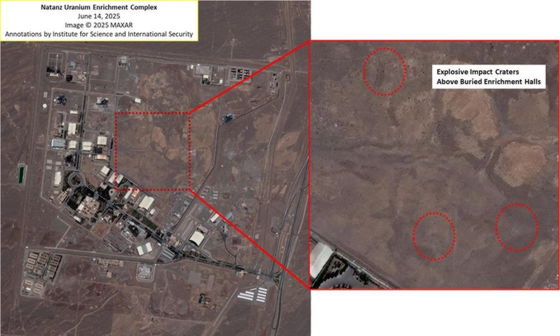
On June 20, Director General of
Furthermore, in the early morning of June 22, 2025, the Natanz nuclear facility was attacked again. This attack was carried out by the US military, and at least one bunker buster hole was confirmed in the buried enrichment facility. The bunker buster hole is the black dot in the red circle in the image below.
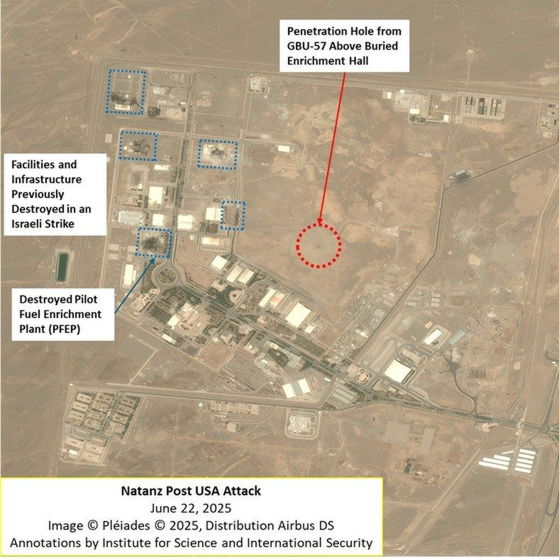
The US Department of Defense announced that at least two
◆ Fordow Facility
The Fordow facility is an underground uranium enrichment facility involved in the production of highly enriched uranium (greater than 20% uranium-235) and weapons-grade uranium (greater than 90% uranium-235). It was built in the early 2000s as part of Project AMAD, Iran's covert nuclear bomb-making program.
Construction of the Fordow facility continued even after the AMAD program ended in 2003, and its existence was uncovered by Western intelligence agencies a few years later. The Iranian government subsequently announced that the Fordow facility was a 'civilian facility for the production of low-enriched uranium,' but inspectors who visited the facility reported that the piping, equipment, and uranium supply station were common to facilities producing weapons-grade uranium.
Below is a general view of the Fordow facility, based on the AMAD factory layout.
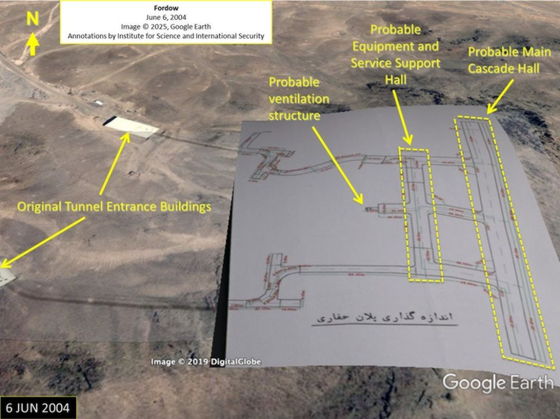
In the early morning of June 22, the US military dropped 12 MOP shells on the Fordow facility. Satellite images taken after the attack show two 'three penetration holes in a row.' These penetration holes are located in the ventilation shafts and service-related structures of the Fordow facility, and ISIS pointed out that they 'became important routes for delivering MOP to the core of the facility deep underground.'
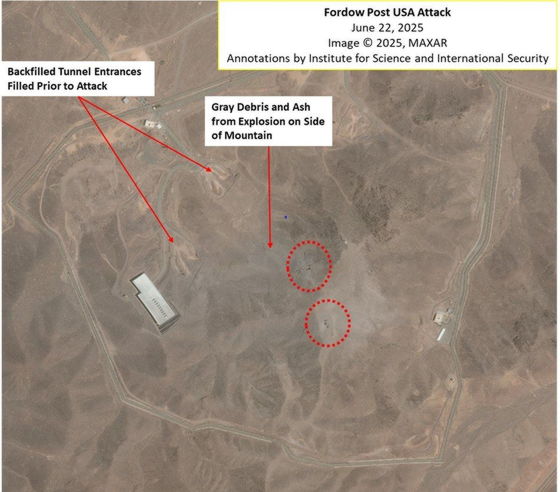
Based on available factory layout plans and satellite images, ISIS concluded that the MOP dropped by the US military was aimed precisely at two vulnerable points in the facility. The first target was commonly known as the 'ventilation shaft,' which connected the underground and central passages and led to the two main underground spaces housing both the equipment and centrifuges shown on the plot map. The other target was located on the other side of the mountain ridge, and it can be seen that the bomb was an unknown structure south of the plot where the centrifuges were installed. This structure was only visible for a short period in late 2009 when it was being installed, and was then covered with soil to hide its presence. The attack was aimed precisely at the edge of the plot where the centrifuges were installed, as well as the structures on the ground, which would have caused the blast to spread throughout the entire plot and completely destroy all of the centrifuges installed.
On June 21, the day before the attack on the Fordow facility, it was reported that the Iranian military was filling in the entrance to the facility with soil in preparation for an attack.
It is also possible that Iran moved enriched uranium from the facility or removed centrifuges and other equipment before filling in the entrance, but ISIS points out that this would have been a very complex and time-consuming operation, and it would have been difficult to remove all the equipment, which would have allowed them to damage the enriched uranium production facilities.
In addition, after the US attack, it was reported that the Israeli military launched another attack on the Fordow facility on June 22-23, but since satellite imagery was not available at the time of writing, it seems that the details of this attack could not be investigated.
Isfahan Nuclear Facility
The Isfahan Nuclear Complex is a facility that includes a uranium conversion facility, multiple uranium conversion and fuel fabrication facilities, natural and enriched uranium storage facilities, and uranium metal production facilities. It has facilities essential for the production of uranium hexafluoride, various forms of uranium oxide, uranium metal, and reactor fuel. Iran built the Isfahan Nuclear Complex as a zirconium production plant to manufacture fuel cladding tubes for nuclear reactors. In addition, on the north side of the facility, there is a tunnel that is part of the nuclear facility built around 2005 and is being renovated from 2020 to 2021. This tunnel was originally reported to the IAEA as a facility for storing highly sensitive materials and equipment in the event of an external attack and for small-scale conversion work.
The Isfahan nuclear facility has been attacked twice by Israel and once by the United States, causing extensive damage.
The first attack took place on June 14, 2025, with satellite imagery confirming damage to four uranium conversion facilities. The enriched uranium metal conversion plant was also destroyed, and what appears to be a shipping and receiving building was severely damaged. The reactor fuel fabrication plant was also partially damaged, as was the central chemical laboratory. However, no damage was observed to the zirconium production plant or the underground tunnels immediately north of the main facility.
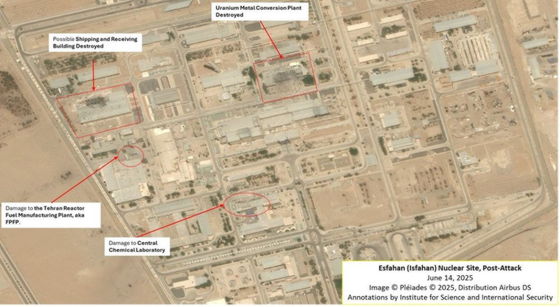
The enriched uranium metal conversion line, which converts uranium tetrafluoride into enriched uranium metal, is a key capability in producing weapons-grade uranium for nuclear weapons. The line has been tested with 20% enriched uranium and can process 90% enriched uranium. Destruction of this facility would halt any Iranian efforts to build a nuclear weapon.
The Reactor Fuel Fabrication Plant at the Isfahan Nuclear Complex is a facility capable of producing natural uranium metal. The facility also stores 20% and 60% enriched uranium, and was reported to have stored 85% of Iran's 20% enriched uranium and 83% of its 60% enriched uranium at the time in August 2023. It is unclear how much 20% and 60% enriched uranium was stored in the building at the time of the attack.
The second attack took place on the night of June 20 to the night of June 21. The IAEA reported that 'six other buildings on the same site were also attacked, including a facility for producing natural and depleted uranium metals, which is not yet operational, a fuel rod production facility, a facility for producing low-enriched uranium pellets, a laboratory and nuclear material storage facility, another laboratory, a workshop for handling contaminated equipment, and an office building not storing nuclear material.'
Furthermore, on June 22, the US military launched a Tomahawk cruise missile from a submarine at the Isfahan nuclear facility, destroying the main uranium conversion facility and tunnels at the facility that convert natural uranium into uranium hexafluoride.

Another important outcome was that the attack on the IR-40 Arak heavy water reactor likely destroyed the reactor there, eliminating a major source of plutonium for use in nuclear weapons.
However, not all of Iran's nuclear facilities were hit in Operation Rising Lion, and ISIS claims that some facilities, especially underground facilities, require further investigation.
ISIS also stated, 'We expect that Israeli intelligence will continue to investigate remaining threats in Iran, including nuclear materials, centrifuges, and weapons production facilities, even under a ceasefire. These threats should be addressed by negotiating a verifiable halt to Iran's uranium enrichment program, as President Trump has stated,' and called for efforts to eliminate any nuclear threats that Operation Rising Lion was unable to destroy.
in Note, Posted by logu_ii